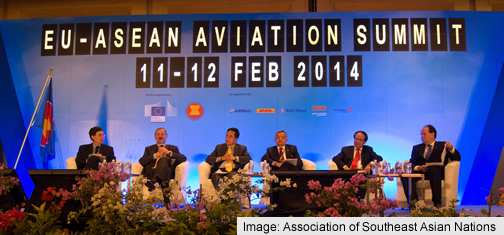Comparing challenges: the EU and ASEAN aviation environments
17 February 2014Last week the Singapore Government hosted the 1st EU – ASEAN Aviation Summit. Jointly organised by the European Commission and the Association of South East Asian Nations the intention of this summit was to enhance political, technical and industrial co-operation in the aviation sector between ASEAN and the EU.
The regions are perhaps surprisingly similar in some senses, with the EU population topping 500 million people and the ASEAN region at around 600 million; both are creating single aviation markets within their region with ASEAN on course to create an ASEAN Single Aviation Market (ASAM) by 2015, which will have many similarities to the more open aviation market in Europe. This offers new opportunities for cooperation between the EU and ASEAN in aviation.
Forecasts indicate the ASEAN region is about to experience an explosion in air travel comparable to that experienced in Europe during the nineties and early 2000s (440% increase in routes within the EU between 1992 and 2013) but over a much shorter timeframe. By 2030 the Asia Pacific region is estimated to have a 38% share of the global aviation market. To service that forecast increase there are more than 3000 aircraft on order with a combined cost of $500billion.
Support services will of course also need to grow to facilitate this incredible growth in traffic and right in the middle of that sit the Air Navigation Service Providers – both in Asia and Europe.
The Europeans have some past experience of this kind of growth and we are well positioned to assist our Asian colleagues – we can help the ASEAN ANSPs deal with this increase in demand more quickly than they might alone, drawing on our experience of both what’s worked well in Europe and what hasn’t worked so well!
Discussions at the Summit talked a lot about open markets and the benefits of liberalisation in aviation. However, one area where it was noted that the EU is facing difficult challenges – implementation of a Single European Sky, is one of the areas where competition has not been introduced in the single EU aviation market – the provision of Air Traffic Services.
This might be something that the ASEAN countries can also learn from a closer relationship with Europe. Whilst air traffic services used to be seen as natural monopolies, the validity of this assumption has been challenged in the last few years. Indeed, where we have seen some liberalisation of Air Traffic Services – for example, where we’ve won contracts to provider tower services in Spain through our partnership with Ferrovial, we’ve seen prices fall and first class service levels, including an excellent safety performance. It may be that in developing an ASEAN Single Aviation Market, the ASEAN States can find a model for air traffic service provision that means they can avoid some of the challenges and obstacles that are still slowing progress here in Europe.
Comments
Please respect our commenting policy and guidelines when posting on this website.
